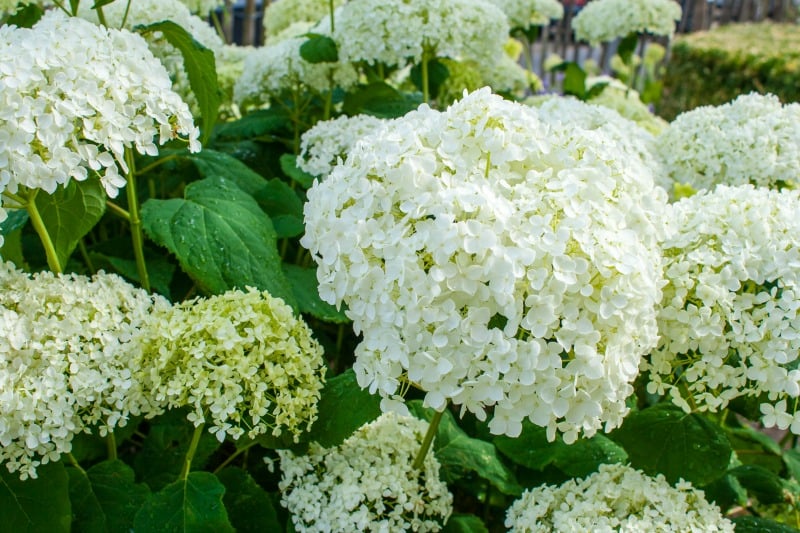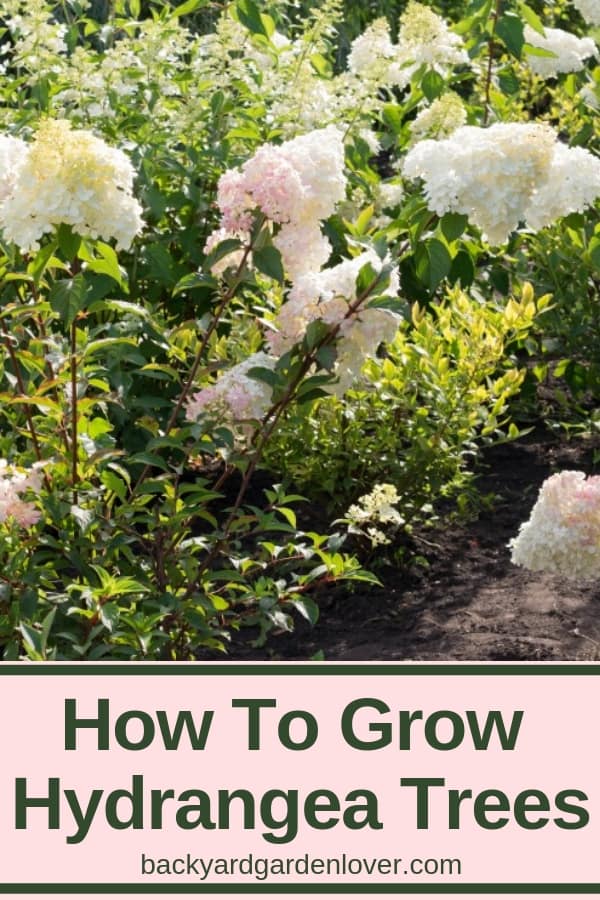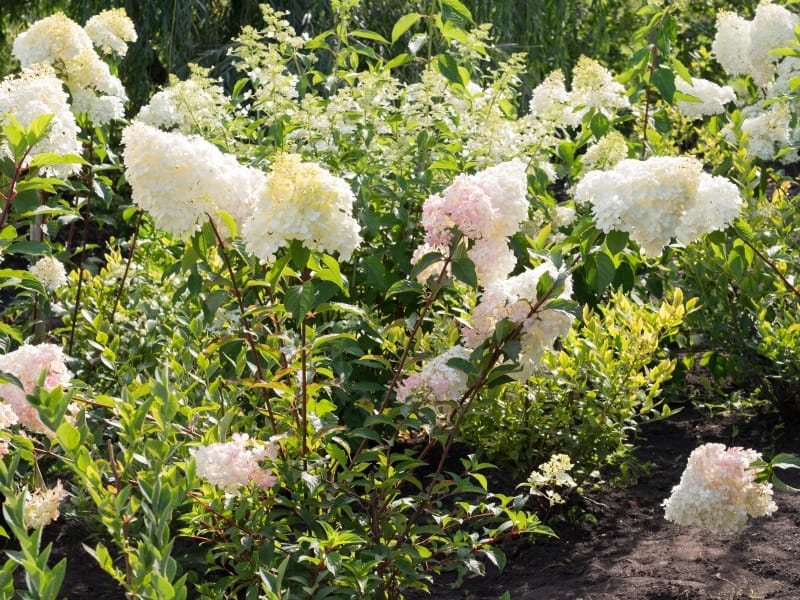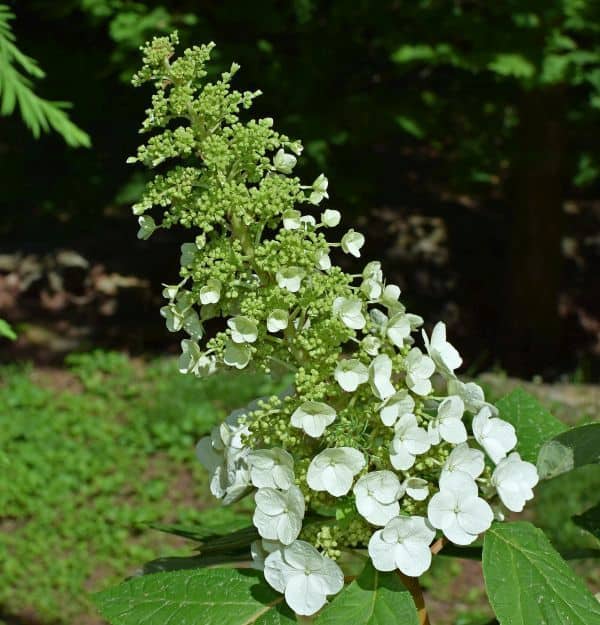I love the carefree nature that hydrangea trees bring to any garden, with their late-blooming clusters of flowers. These versatile trees are one of the easiest ornamentals to maintain, thriving in shady locations and well-drained soil.
There are over 100 varieties of hydrangeas trees varying in size, color, and shape. It can often be difficult to choose which one to plant in your garden. Here is some information about the different types of hydrangea trees and tips for planting them.
What Is a Hydrangea Tree?
We’re all used to the gorgeous hydrangea bushes, blessing our gardens with their beauty. But … have you heard of hydrangea trees? A hydrangea tree is nothing more than a shrub of Hydrangea paniculata that has been trained to grow tall like a tree.
If you’re adventurous, you can train it yourself over a few years: cut the outside branches and leave the sturdier middle ones that grow up straight. Or, head over to your local garden center and see if you can find one there. Or, take a look on Amazon.
Can I grow a hydrangea tree in a pot?
Absolutely! These delicate trees do great in pots. They are easy to move around and great for decorating your front door or back porch. Just make sure to keep it watered properly, and enjoy it 😉
Wonder what kind of pots to use for your new tree? These large outdoor planters would work great!
Hydrangea Tree Varieties
Panicle Hydrangea Trees
Panicle hydrangea includes all trees in the hydrangea paniculata family and can adapt to many different growing conditions and regions. Unlike some other varieties of hydrangeas, these plants grow new buds in spring, so it’s unlikely that they will freeze. Because of this, panicle hydrangea trees flower annually and are some of the most cold-tolerant of all hydrangea varieties. The elongated cone-shaped flower clusters signature to these trees bloom mid-summer, lasting until mid to late fall.
Here are just a few of the panicle hydrangeas you might want to try:
- limelight
- little lime
- bobo
- pinky winky
- quick fire
- tardiva
Love hydrangeas? Learn how to care for them, with this easy hydrangea care guide. And if you ever wished you could change the color of your hydrangea flowers, try this trick here (only works for certain types of plants)!
Limelight Hydrangea Tree
Part of the hydrangea paniculata taxonomy, the limelight hydrangea tree is one of the easiest hydrangeas to care for. These cold-hardy trees can withstand temperatures as low as 30 degrees F, making them a perfect option for gardeners in colder regions.
With voluminous, cone-shaped flowers, limelight hydrangeas trees will give a bold accent to your garden. These dwarf trees grow to about 6 feet tall and can be grown directly in the soil or as a potted plant.
Vanilla Strawberry Hydrangea Tree
If you’re looking to add a pop of color to your garden, consider growing the vanilla strawberry hydrangea tree. This French hybrid looks exactly as it sounds, flowering mid-summer with cream-colored petals that slowly turn to a vivid fuchsia by early fall. This shrub grows to 7 feet tall and thrives in areas with morning to afternoon sun, with some partial shade.
PeeGee, also known as Pee Gee Hydrangea Tree
If you want a larger flowering tree for your garden, consider planting a pee gee hydrangea tree that grows up to 25 feet in height in certain growing conditions.
These trees grow white cone-shaped flowers that slowly change to a light pink through the summer and fall. Another member of the paniculata family, this tree is characterized by its loose and staggering clusters of flowers. These hydrangea trees grow best in full sun, with a well-drained, slightly acidic soil.
Oakleaf Hydrangea Tree
Gorgoeus Native Plant,Huge Oak Like Leaf Ruby Slippers Oakleaf Hydrangea
Ruby Slippers Oakleaf Hydrangea  Little Honey Dwarf Oakleaf Hydrangea
Little Honey Dwarf Oakleaf Hydrangea 
The oakleaf hydrangea tree, native to the American southeast, is a great option if you are in need of a smaller variety to accentuate your garden. With cultivars varying between 3-6 feet in height, this hydrangea tree provides a bold accent to a garden border or woodland area.
Known for their large, textured leaves resembling those of oak trees, their foliage is their best feature. Throughout the fall, these leaves deepen to a warm burgundy hue, scattered with white flower clusters.
Oakleaf hydrangea trees grow best in well-drained, acidic soil and can tolerate full sun more than other varieties. They are the only variety we listed that bloom on old growth, so make sure that you prune immediately after its flowers fade.
Snowball Hydrangea Tree

It’s easy to see how snowball hydrangea trees got their name, with large, round flower clusters resembling puffy mounds of snow.
Like the panicle hydrangea, this tree is a great option for colder climates, as new growth is not impacted by spring frosts. It is shade tolerant and prefers well-drained, moist soil. Snowballs are a shorter hydrangea variety, growing between 3-5 feet tall, but their blooms are a real showstopper, growing as large as 10 inches in diameter on some cultivars.
Planting Hydrangea Trees
Hydrangeas are woodland plants, so they thrive in partially moist, organically rich, well-drained soil. When planting, choose areas of your garden that provide morning and afternoon sun, with shade in late afternoon and protection from strong winds.
Without any shade, they are more susceptible to wilting and bleached leaves in hot summer temperatures.
When can I plant my hydrangea tree?
Plant your hydrangea tree in the spring or fall, in a hole as deep as the root ball and two times as wide, leaving between 3-10 feet between plants. Make sure your plant is dormant if you’re transplanting, and that it no longer has leaves or blooms.
Add organic material to your planting site if working with poor soil and soak the roots of your hydrangea tree before planting.
Pruning Hydrangea Trees
Hydrangea trees are actually shrubs that have been trained to grow as trees. Because of this, pruning is necessary for maintaining the shape of your tree.
Remember, most hydrangea trees, except for the oakleaf hydrangea, bloom on new growth. This means that the best time to prune is fall to late spring, before any new foliage sprouts.
If you are caring for an oakleaf, prune immediately after flowers fade in mid to late fall.
When pruning, cut all weak or crossing branches. Leave at least 6 inches between the lowest branches and the ground.
Prune to a tree shape, with one long “trunk”, cutting all shoots from the base of the shrub. For a round, tree-shaped crown, cut branches back closer to the main trunk, leaving some branches at the top. Pruning is not necessary for your hydrangea tree annually, but if it looks unruly or contains many dead branches, it is probably time to trim it back.
How To Water My Hydrangea Tree
Make sure to water your hydrangea tree thoroughly, especially right after planting. Hydrangeas absorb water very quickly and should be watered up to twice per day in sunnier locations.
If your hydrangea tree is planted in partial shade, you will not have to water it as frequently. Factor in variables like species, temperatures, type of soil, and amount of precipitation when deciding how often to water your tree.
Generally, the best method is to water enough to avoid wilting, usually two to three times per week. Optimal watering times are in the morning or evening, rather than during times of peak heat. Avoid over-watering or excessive moisture on the leaves of your tree, which can lead to gray mold, or botrytis, especially in more humid climates.
Caring For Hydrangea Trees
For regular maintenance, be sure to add a mound of compost with pine needles or leaves to the base of your hydrangea tree annually. Mulching this area can also be beneficial, especially in areas with strong winds or colder climates.
The pH of your soil can also impact the growth of your tree if it is alkaline. To make the soil more acidic, a natural mulch of sphagnum moss, pine bark, or coffee grounds can be used.
For gardeners in colder climates, prepping your hydrangea tree for the winter is an important part of your care routine. Many gardeners cut off dead blooms in the winter to keep their plant from bowing. In areas with particularly harsh winters, it is always a good practice to shield your hydrangea from the wind by wrapping the trunk with newspaper or burlap and mulching the roots.
Can You Grow Hydrangea Trees From Cuttings
You might wonder if you can grow hydrangea trees from cuttings. The answer is yes and no. New hydrangea plants can be easily grown from cuttings of well-established plants. To do so, find a new growth branch that has not flowered and make a horizontal cut about 5 inches from the base. Remove the lower leaves on the stem and cut any large leaves down to about half of their size.
Plant the cutting in a well-drained pot with organically rich soil and set it in a shady area. Be sure to water the pot well after planting, and water again any time the top layer of soil is dry. Your new hydrangea will grow roots within 2-3 weeks.
But to make this new hydrangea plant into a tree, you’ll need to train it, just like you did with your initial hydrangea tree. It can take a couple of years or more to have a new hydrangea tree, but it can be done.
Where to Buy Hydrangea Trees
If you’re not sure where to buy your hydrangea tree, check out your local gardening or home improvement store. Remember, it’s best to plant your new tree in fall or spring when there’s no chance of frost.
These gorgeous trees brighten up any garden with their eye-catching blooms symbolic of late summer weather. Choose a partially shaded, well-drained corner of your garden to plant this low-maintenance tree, and it is guaranteed to bloom year after year. With spring approaching, now is the perfect time to decide which hydrangea tree to plant in your garden!









The 6 Most Popular Types Of Hydrangeas To Choose For Your Garden
Friday 21st of January 2022
[…] are some tips for growing hydrangea trees in your […]
Rose
Saturday 11th of September 2021
I have 6 Oakleaf hydrangea trees for 18yrs. They are Beautiful! Never trimmed them! Just let them grow wild & tie them up
Beautiful Flower Garden Ideas
Tuesday 23rd of February 2021
[…] Tips For Growing Hydrangea Trees in Any Garden […]
Pink Flowering Shrubs For Any Garden
Friday 3rd of July 2020
[…] growing hydrangea trees […]
Mae
Tuesday 16th of July 2019
My son has a purple hydrangea that looks like an evergreen shrub in the winter! It’s the most beautiful hydrangea I have ever seen! I have two hydrangeas. One was turning into a blue color but I didn’t add anything to it this spring and now it’s pretty pink. I am going to try to add something to it again next spring and see if it will turn out blue again